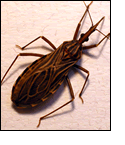Return to Online
Education Kit
|
 |
 |
 Previous Event | Next Event Previous Event | Next Event 
2005: Trypanosomatid Genomes Sequenced

Trypanosomes are a family of protozoan parasites that cause severe disease in animals and humans. International collaborations of scientists published the genome sequences of three species that cause human disease worldwide.
- Trypanosoma cruzi is the causative pathogen for Chagas’ disease. This disease is found in central and northern South America, Central America, and Mexico. Chronic infections result in various neurological disorders and damage to the heart muscle. If left untreated, infections are often fatal.
- Trypanosome brucei causes African sleeping sickness. There are two subspecies of the parasite. One infects wild game and the other infects humans. Both subspecies are spread by the tsetse fly. Infections produce a variety of symptoms including malaise, swollen tissues, headache and intermittent fevers. Advanced infections damage the central nervous system and can lead to coma and death.
- Leishmania major causes a spectrum of diseases that depend on host and parasite genetic factors. The parasite affects human populations worldwide and is spread by blood sucking sand flies. Infections produce lesions of the skin and mucous membranes. Internally, the parasite attacks the liver and spleen. Untreated infections can be fatal.
These organisms infect millions of people worldwide and cause thousands of deaths each year. It is anticipated that the genome sequence data will serve as a basis for enhancing understanding of the complicated lifecycles of these parasites. Such understanding is critical to the development of effective vaccines and treatments.
More Information
References:
Cross, G.A.M. Trypanosomes at the gates, Science 309: 355. 2005. [PubMed]
El-Sayed, N.M., Myler, P.J., Blendin, G., et al. Comparative genomics of trypanosomatid parasitic protozoa. Science, 309: 404-409. 2005. [PubMed]
 Previous Event | Next Event Previous Event | Next Event 
Last Reviewed: April 17, 2008
|

